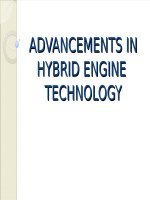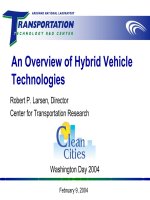Động cơ Hybrid - hybrid-engine
Bạn đang xem bản rút gọn của tài liệu. Xem và tải ngay bản đầy đủ của tài liệu tại đây (1.02 MB, 20 trang )
ADVANCEMENTS IN
ADVANCEMENTS IN
HYBRID ENGINE
HYBRID ENGINE
TECHNOLOGY
TECHNOLOGY
Introduction
Introduction
Definition
Need for hybrid engines
Brief History
Definition
Definition
Hybrid Engines are typically described as
engines with two power sources.
A hybrid electric vehicle (HEV) is a type of
hybrid vehicle and electric vehicle which
combines a conventional
internal combustion engine (ICE) propulsion
system with an electric propulsion system.
Need for hybrid engines:
Need for hybrid engines:
Greener Earth
Global warming
Sustainable development
Increasing price of fuel
Electric Motor
Electric Motor
Lots of torque
Zero emissions
Tax breaks
No transmission needed
Starts more efficiently
◦
Can turn off motor when you stop
Gasoline
Gasoline
Higher energy density than batteries
◦ 1,000 pounds of batteries = 1 gallon (7 pounds) of
gas
Cheaper initial cost for car
◦ Hybrids are $3500-5000 more
Reliable, more history
Brief History:
Brief History:
1900 - Ferdinand Porsche developed a gasoline-electric
hybrid
1997 – Toyota Prius
1999 – Honda Insight
2000 – Hybrids become core market
Advancements in hybrid
Advancements in hybrid
powertrains
powertrains
Hybrid electric vehicles can be classified according to the
way in which power is supplied to the drivetrain:
PARALLEL HYBRIDS:
In parallel hybrids, the ICE and the electric motor are both
connected to the mechanical transmission and can
simultaneously transmit power to drive the wheels.
Usually parallel hybrids can use a smaller battery pack as
they rely more on regenerative braking and the internal
combustion engine can also act a generator for supplemental
recharging.
Parallel hybrids are more efficient for highway driving than in
urban stop-and-go conditions.









